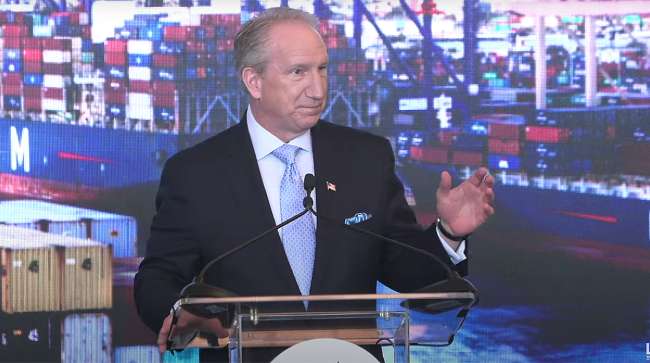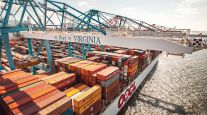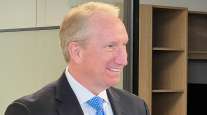Senior Reporter
Port of Los Angeles Leader Outlines Ambitious Goals for 2024

[Stay on top of transportation news: Get TTNews in your inbox.]
With billions of federal, state and local dollars now being spent at the nation’s sea and inland ports, these critical economic engines are poised to accelerate their efforts toward low- and zero-carbon emissions, and grow as ports and shippers develop a post-COVID economic model.
That was the key message at the annual State of the Port address in Los Angeles, where port leaders announced that the facility is once again the busiest container port in the nation.
“In 2024, we’ll continue our progress on cargo growth and efficiency because that’s our largest generator of jobs across southern California,” Gene Seroka, executive director of the Port of Los Angeles, told the audience Jan. 10.
“Economies are systems and, just like everything else on the planet, they run in seasons and cycles,” he said. “Whatever the forces of global trade have in store for us, we’ll be ready. We’ll be resilient. And we’ll be responsible for better outcomes for those who count on us. Through it all, one thing remains the same for the 24th consecutive year: The Port of Los Angeles ranks as the nation’s No. 1 container port.”
Meanwhile, at neighboring Port of Long Beach, CEO Mario Cordero will give his annual State of the Port speech Jan. 17.
Seroka explained his vision for the port regarding economic growth and environmental actions.
“The good news is that global trade is now edging up and we are looking forward to a return to more normal cargo volume levels in the year ahead,” Seroka said in an address sponsored by the Pacific Merchant Shipping Association.
He said cargo volumes for 2023 will reach an estimated 8.6 million containers, down about 13% compared with 2022’s record year. Still, he pointed out that the last five months of 2023 were strong, and the port picked up market share, especially after the International Longshore and Warehouse Union and the Pacific Maritime Association announced a five-year labor agreement after more than a year of negotiations.
Concerning environmental issues, Seroka said both Los Angeles and Long Beach are ramping up their efforts to develop a green hydrogen hub in California with $300 million in federal funding, and the state and others contributing another $300 million.
In his 9th annual ‘State of the Port’ address today before a sold-out crowd of more than 575 community, business and labor stakeholders, Port of Los Angeles Executive Director Gene Seroka presented the Port’s top initiatives and plans for the coming year. https://t.co/otZhIjJueE pic.twitter.com/wPmz4fGK1B — Port of Los Angeles (@PortofLA) January 10, 2024
“With this funding, our ports will play a leading role in the green hydrogen market in Southern California. On this side of San Pedro Bay, our initial investments will help purchase dozens of hydrogen-powered cargo-handling units and build their necessary fueling infrastructure,” he said.
Peter Vaughan Schmidt of Torc and Joanna Buttler of Daimler Truck discuss the timeline for autonomous trucks entering the market and how they could blend into existing fleet operations. Tune in above or by going to RoadSigns.ttnews.com.
Seroka also updated the audience on California’s goals for transitioning all cargo handling equipment to zero emissions by 2030 and all drayage trucks calling at marine terminals to zero emissions by 2035.
“Since I spoke to you last January, the number of ZE trucks in our drayage registry grew from 56 to 195. That’s progress but still a very small percentage of the 20,000 trucks that serve our ports,” he said, pointing out that Los Angeles and Long Beach plan to increase the numbers using the funding under the Clean Truck Fund Rate program, which has spent an estimated $115 million to get cleaner, zero- or low-emission trucks through the two ports. Seroka said the two ports are in a similar position to where they were in the early part of the century when they began another ambitious pollution reduction effort.
“Assembly lines for those future ZE trucks aren’t fully ramped up, and the price is beyond the reach of most of our truckers. But keep in mind we’re creating a market that doesn’t exist yet, just like we did with shore-side power 20 years ago,” he said to applause. “People thought we were crazy for investing tens of millions of dollars to electrify our berths to reduce our in-port emissions, yet it worked.”
Seroka acknowledged that emissions did increase during the coronavirus pandemic, as more than 100 ships were sitting in San Pedro Bay for sometimes weeks waiting for a berth to be unloaded. He said emissions improved in 2023.
Want more news? Listen to today's daily briefing above or go here for more info
“While we took some criticism for the previous spike in admissions, we acknowledge it. That said, everyone should know that the ports of Long Beach and Los Angeles take our environmental goals seriously,” he said.
Seroka said the Green Shipping Corridors initiative is gaining momentum, citing partnerships with ports in China, Japan, Singapore and Vietnam. They focus on reducing carbon emissions using zero-emission trucks, terminal equipment and, gradually, cleaner ocean vessels for products coming in through critical international shipping routes.





